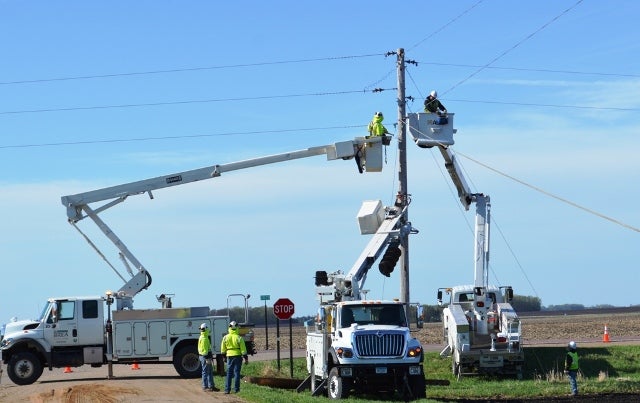From humble beginnings, Brown County Rural Electrical Association (REA) became a reality for many due to the hard work and perseverance of a few.
In 1936, the Rural Electrification Act was signed by President Roosevelt. Bulletins about the program were brought to the farmers’ attention by Farm Bureau County Agent Paul Kunkel. Led by John Mack, nine men set out across the county with applications to sign up farmers for electric service and membership in the cooperative. These men were Robert Runck, Sr, Elmer Hovde, Oscar Lilleodden, Charles Wiltscheck, Ed LeBert, Ferd Dittbenner, A.P. Zschetzsche, and A.A. Anderson.
Zschetzsche recalled, in a later interview, the difficulty of this task. “You must remember that times were far different from what they are today. In Brown County alone, we had a drought year. Our corn yield had averaged only 27 bushels per acre, while flax was down to about 9 bushels and oats averaged only 23 bushels.” There was a strong fear that membership in the cooperative would cause one to lose their farm.
On December 11, 1936, a telegram was received from REA headquarters announcing that $166,500 had been allocated for Brown County REA to build 166.5 miles of rural power lines. There was a mass meeting on March 15, 1937 to sign the Articles of Incorporation. A total of 242 members bought their shares in the cooperative at that meeting. The incorporators and first board of directors included Edmund Le Bert, Robert Runck, Sr, Joseph Mathiowetz, Herman Reinarts, Arthur Zschetzsche, Arthur Walser, Carl Olstad, and George Brudelie.
On January 18, 1938, the cooperative energized lines at the Milton, Lester and Harold Berkner farms north of Sleepy Eye, making them the first to receive electricity from Brown County REA. In that first year, 353 farms were energized.
Brown County REA purchase power from the municipal power plants in New Ulm, Sleepy Eye and Springfield. As electric loads in the cities and the country grew, taxing the municipal power plants, Brown County REA approved a connection to Northern States Power Company lines. Growth in electric demand and the need to guarantee reliable wholesale power prompted the coop to join other electric coops from southwest and west central Minnesota as a member of Cooperative Power Association in 1956.
By the mid-1970s, increasing demand for electricity led to the construction of an 1,100 megawatt coal-fired power plant in North Dakota called Coal Creek Station. When Coal Creek Station was built, Cooperative Power and United Power, a generation and transmission company which served coops in northern Minnesota, worked together to manage the power plant. In 1999, these two cooperative generation and transmission cooperatives joined forces to form Great River Energy, which now supplies wholesale power to 28 electric cooperatives in Minnesota.
Brown County REA has had four general managers in its history, to date:
1937 - 1975: Hillman A. Rosseth: In addition to be instrumental in getting the cooperative off the ground, some of his great accomplishments include the construction of the current headquarters building and the rotation of vehicles to keep the fleet current.
1975 - 2001: Leslie Schrupp: Les moved the cooperative into the age of technology by bringing in the first computers shortly after he started.
2001 - 2017: Wade Hensel: Position shared with BENCO Electric, North Mankato.
2017 - Present: Michael Heidemann

